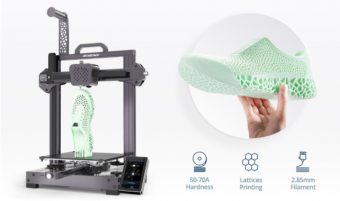Atomstack, a Chinese intelligent manufacturing technology company, released its Cambrian line of desktop rubber 3D printers, a first for desktop printing. The printers promise greater prototyping and faster production of customized rubber items.
Cambrian has a sleek, all-metal framework of anodized aluminum alloy with a specially designed patterned glass hotbed platform that improves printing quality by keeping the extruded filament warm to prevent warping. The compact, desktop design keeps all control cables hidden and all major components are made of high-strength aluminum which provides the rigidity needed for accurate prints. Cambrian’s 4.3″ touchscreen LCD is an easy-to-use control panel. With it, users can precisely control the temperature of the hotbed and extruder, set printing parameters, and see print previews, ensuring a simple, intuitive printing experience with great results every time.
The company is marketing the new printing on Kickstarter, where it has raised over $500,000 HKD. The printer’s two versions, Pro and Max, are available for $339 and $379, respectively. The printers provide reasonable desktop build volumes, with the Pro sporting a 235 x 235 x 250 mm build platform; the Max can build up to 320 x 320 x 380 mm.
Manufacturing on Demand

The rubber that Atomstack uses for its Cambrian printers is highly elastic and resilient. The thermoplastic rubber This property allows desktop printing a new range of products alongside typical plastic filaments like PLA, TPU, TPE, ABS and PETG.
Jason Li, Atomstack’s CEO, commented on the product launch:
For years, the FDM 3D printing industry has been trying to develop a reliable way to print with rubber-like filaments. This has been difficult for a number of reasons including the fact that highly elastic filament materials are prone to jamming. To solve these problems, we had to rethink the entire process. We began by designing a new 2.85mm direct extruder design that eliminated nozzle jams, then we developed special rubber filament TPR (Thermo Plastic Rubber) with a high elasticity (50-70A hardness) and resiliency ( >50%) capable of accurately and reliably printing virtually any end-use rubber products.
* This article is reprinted from 3D Printing Media Network. If you are involved in infringement, please contact us to delete it.
Author: Adam Strömbergsson



Leave A Comment